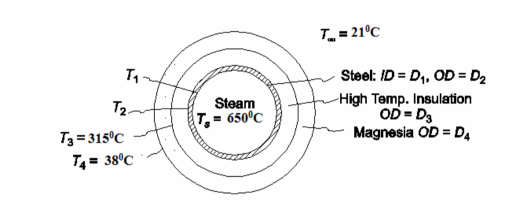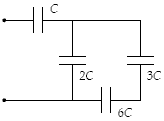A 10-mH inductor is connected in series with a 10-ohm resistor, a switch and a 6-volt battery. What is the time constant of the circuit? How long after the switch is closed will the current reach 99 percent of its final value?
1.0 ms, 4.6 ms
You might also like to view...
A standard 4 10 cm steel pipe (ID = 10.066 cm., OD = 11.25 cm) carries superheated steam at 650°C in an enclosed space where a fire hazard exists, limiting the outer surface temperature to 38°C. To minimize the insulation cost, two materials are to be used; first a high temperature (relatively expensive) insulation is to be applied to the pipe and then magnesia (a less expensive material) on the outside. The maximum temperature of the magnesia is to be 315°C. The following constants are known.

(a) Specify the thickness for each insulating material.
(b) Calculate the overall heat transfer coefficient based on the pipe OD.
(c) What fraction of the total resistance is due to (1) steam-side resistance, (2) steel pipe
resistance, (3) insulation (combination of the two), and (4) outside resistance?
(d) How much heat is transferred per hour, per foot length of pipe?
GIVEN
• Steam filled steel pipe with two layers of insulation
• Pipe inside diameter (Di) = 10.066 cm=0.10066 m
• Pipe outside diameter (Do) = 11.25 cm=0.1125 m
• Superheated steam temperature (Ts) = 650°C
• Maximum outer surface temperature (Tso) = 38°C
• Maximum temperature of the Magnesia (Tm) = 315°C
• Thermal conductivities
? High-temperature insulation (kh) = 0.1 W/(m K)
? Magnesia (km) = 0.076 W/(m K)
? Steel (ks) = 43 W/(m K)
• Heat transfer coefficients
? Steam side ( ci h ) = 500 W/(m2 K)
? Outside ( co h ) = 11 W/(m2 K)
• Ambient temperature (Ta) = 21°C FIND
(a) Thickness for each insulation material
(b) Overall heat transfer coefficient based on the pipe OD (c) Fraction of the total resistance due to
? Steam-side resistance
? Steel pipe resistance
? Insulation
? Outside resistance (d) The rate of heat transfer per unit length of pipe (q/L) ASSUMPTIONS
• The system is in steady state
• Constant thermal conductivities
• Contact resistance is negligible
SKETCH

Determine the equivalent capacitance of the combination shown when C = 45 ?F

a.
28 ?F
b.
36 ?F
c.
52 ?F
d.
44 ?F
e.
23 ?F
What would happen if a white dwarf gained enough mass to reach the 1.4 solar-mass white dwarf limit?
A) The white dwarf would explode completely as a white dwarf supernova. B) The white dwarf would collapse in size, becoming a neutron star. C) The white dwarf would undergo a nova explosion. D) The white dwarf would collapse to become a black hole.
Briefly discuss the effect of active galaxies on the clusters of galaxies
What will be an ideal response?